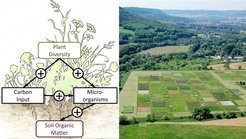Species diversity protects the climate

The richness of species in an ecosystem is not only a source of joy for nature lovers; it also defines an ecosystem’s functional characteristics and potentially maintains stability with climate change. For example, ecosystems dominated by plants play a central role in the global carbon cycle: through photosynthesis, grasses, trees, and other plants transform atmospheric carbon dioxide into plant biomass. The carbon they bind in this way then reaches the soil as organic matter via plant litter and root exudates and can be stored there. The fact that extensive plant diversity promotes the storage of carbon in the soil has already been demonstrated by previous studies; however, the exact mechanism behind this process was not known up to now.
An international research team headed by Gerd Gleixner and Markus Lange both scientists at the Max Planck Institute for Biogeochemistry in Jena, investigated why ecosystems with extensive species diversity bind more carbon than others with fewer species. To do so they used the test plots of the Jena Experiment, a long-term project being carried out jointly by the Max Planck researchers and the Friedrich Schiller University Jena to examine the influence of biodiversity on elemental fluxes in nature. The research team compared grasslands of different species composition which had been exposed to the same environmental conditions for a nine-year period. The scientists observed that, unlike their species-poor counterparts, species-rich grasslands provide the soil microorganisms with more nutrients and substances, and at the same time offer more favorable environmental conditions. “These factors led to greater genetic diversity and, in particular, to increased activity on the part of the microbial community,” says Markus Lange, first author of the study.
A high level of biodiversity appears to alter the metabolism of the microorganisms
Unexpectedly, the increased microbial activity did not result in the loss of carbon-rich matter in the soil as decomposition did not appear to increase. On the contrary, the microbial community added more carbon to the soil because it converted more plant biomass. “In the presence of greater biodiversity, the microorganisms’ metabolism appears to have shifted towards anabolic activity,” says Lange, explaining the study findings. Moreover, as demonstrated by the age determination of the carbon molecules in the soil based on natural isotopes and carbon flow modelling, this “microbial” carbon is stored in the soil for longer. The study thus demonstrates, for the first time, that a high level of plant diversity results in the long-term storage of carbon in the soil because it gives rise to a more varied composition and greater activity on the part of the microbial community.
From a global perspective, plant-rich ecosystems are particularly important for storing atmospheric carbon dioxide which would otherwise as greenhouse gas increase the warming of the Earth. How-ever, biodiversity is constantly being reduced through the impacts of climate change and increasing land use, and has reached a stage of global decline and species loss. “Once again, our findings high-light the importance of biodiversity for important ecosystem functions like carbon storage,” says Gerd Gleixner. “The conservation of a high level of biodiversity ultimately sustainably counteracts the increasing accumulation of the greenhouse gas carbon dioxide in the atmosphere and hence climate change as well.”
The study of the Max Planck Institute for Biogeochemistry in Jena was published on April 7, 2015 in Nature Communications. The international research team was completed by Prof. Nico Eisenhauer (German Centre for Integrative Biodiversity Research (iDiv) Halle-Jena-Leipzig), Prof. Robert I. Griffith (Centre for Ecology & Hydrology, Wallingford,UK) as well as scientists from the Georg August University Göttingen, the Humboldt University Berlin, the Friedrich Schiller University Jena, and the Centre national de la recherche scientifique (CNRS), Montferrier-sur-Lez, France. (ml, ef)
Original publication
Plant diversity increases soil microbial activity and soil carbon storage
Markus Lange, Nico Eisenhauer, Carlos A. Sierra, Holger Bessler, Christoph Engels, Robert I. Griffiths, Perla G. Mellado-Vázquez, Ashish Malik, Jacques Roy, Stefan Scheu, Sibylle Steinbeiss, Bruce C. Thomson, Susan E. Trumbore, Gerd Gleixner. Nature Communications. DOI: 10.1038/ncomms7707
Contact apl. Prof. Dr. Gerd Gleixner
Dpt. Biogeochemical Processes
MPI for Biogeochemistry
07745 Jena, Germany
Phone: 03641-576172
Email: gerd.gleixner@bgc-jena.mpg.de
Dr. Markus Lange
Dpt. Biogeochemical Processes
MPI for Biogeochemistry
07745 Jena, Germany
Phone: 03641-576168
Email: mlange@bgc-jena.mpg.de
